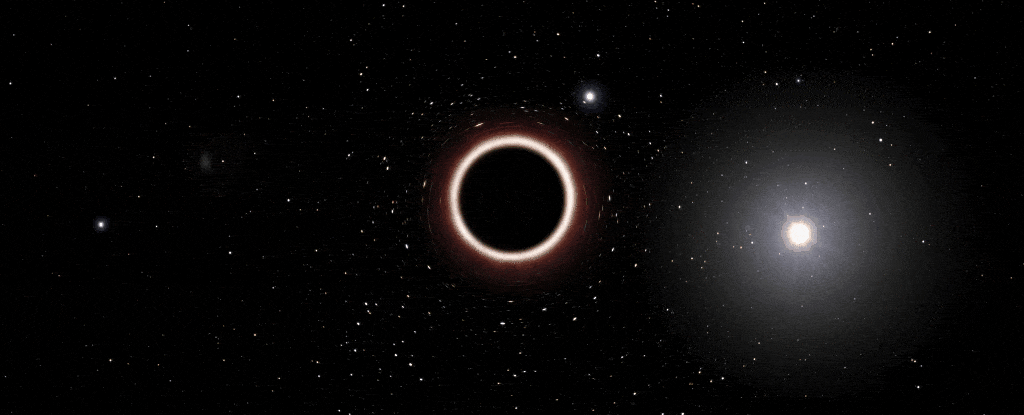Products You May Like
We sort-of take it for granted that there’s a supermassive black hole at the center of the Milky Way galaxy, but we can’t really go there and check. What if something else is actually lurking in this messy, dusty region?
We partially infer the presence and properties of a supermassive hole called Sagittarius A* (Sgr A*) from the gravitational effect it has on other objects, like the extreme orbits of objects like stars around that galactic center… but what if we’re wrong?
What if it’s not a black hole at all? What if it’s a core of dark matter? According to a new and fascinating study, those observed orbits of the galactic center, as well as the orbital velocities in the outer regions of the galaxy, might actually be easier to explain if it was a core of dark matter at the heart of the galaxy, rather than a black hole.
The paper has been accepted into MNRAS Letters, and is currently available on preprint server arXiv. But first, here’s a little background on where this wild hypothesis comes from.
In the last two decades, the orbit of a star named S2 has been the subject of intense scrutiny. It’s on a 16-year orbit around the galactic center, a long elliptical loop that’s served as the perfect laboratory for one of the most extreme tests of general relativity to date.
In previous research, two separate teams showed that not only did relativity hold up in the galactic center spacetime environment, but the results were also consistent with a supermassive black hole 4 million times the mass of the Sun.
Then along came an object called G2. Also on a long, elliptical orbit, G2 did something strange when it came around its periapsis in 2014, the point in its orbit closest to the putative black hole. It went from a normal, compact object to something long and stretched out, before shrinking back down to a compact object again.
This was really weird, and G2’s nature is still unknown. But whatever it is, the object’s motion following periapsis seems to exhibit drag – which, according to a team of astrophysicists led by Eduar Antonio Becerra-Vergara of the International Center for Relativistic Astrophysics, headquartered in Italy, is not entirely consistent with the black hole model.
The researchers showed last year that S2 and G2 were consistent with a different model, even with that strange post-periapsis motion: dark matter fermions, which they dub ‘darkninos’, with a light-enough mass that wouldn’t see them collapse into a black hole until there was at least 100 times as much of the stuff.
That would allow it to still hang about as a huge, dense blob in the center of the Milky Way, and be surrounded by a diffuse fog towards its edges and out into the reaches of the galaxy.
S2 and G2 aren’t the only objects orbiting the galactic center, though. So now the researchers have extended their model to the 17 best-characterized stars zooming around the galactic center, known as S-stars – and you’ll never guess what they found.
Yep, their analysis fits there, too. According to their calculations, there could be a dense dark matter blob in the galactic center, thinning out to a diffuse concentration at the galactic outskirts.
As we have previously reported, dark matter is undeniably one of the biggest mysteries of the Universe as we know it. It’s the name we give to a mysterious mass responsible for gravitational effects that can’t be explained by the stuff we can detect by other means – the normal matter such as stars, dust, and galaxies.
For example, galaxies rotate much faster than they should if they were just being gravitationally influenced by the normal matter in them; gravitational lensing – the bending of spacetime around massive objects – is far stronger than it should be. Whatever is creating this additional gravity is beyond our ability to detect directly.
We know it only by the gravitational effect it has on other objects… sound familiar? But active galactic nuclei, such as the Universe’s most photogenic supermassive black hole, M87* (about 6.5 billion times the mass of the Sun), seem much more consistent with the black hole model.
The team proposes that, above a critical mass, a dark matter clump could gravitationally collapse into a supermassive black hole. This could help explain how supermassive black holes come to exist in the first place, since we have no idea how they get so big – and certainly not how so many of them appear in the early Universe, before they should have had time to form.
Roughly 80 percent of the matter in the Universe is thought to be dark matter. There aren’t enough black holes, supermassive or otherwise, to account for all of this dark matter, but the team isn’t proposing that this is where all the stuff is. Rather, their approach offers a dark matter candidate that could also help explain the existence of supermassive black holes.
Future analysis that either agrees with or pokes holes in their findings can only help constrain these phenomena, ultimately bringing us closer to the truth.
The research has been accepted by MNRAS Letters, and is available on arXiv.
